Developmental differences in genome replication program and origin activation
- PMID: 33264404
- PMCID: PMC7736824
- DOI: 10.1093/nar/gkaa1124
Developmental differences in genome replication program and origin activation
Abstract
To ensure error-free duplication of all (epi)genetic information once per cell cycle, DNA replication follows a cell type and developmental stage specific spatio-temporal program. Here, we analyze the spatio-temporal DNA replication progression in (un)differentiated mouse embryonic stem (mES) cells. Whereas telomeres replicate throughout S-phase, we observe mid S-phase replication of (peri)centromeric heterochromatin in mES cells, which switches to late S-phase replication upon differentiation. This replication timing reversal correlates with and depends on an increase in condensation and a decrease in acetylation of chromatin. We further find synchronous duplication of the Y chromosome, marking the end of S-phase, irrespectively of the pluripotency state. Using a combination of single-molecule and super-resolution microscopy, we measure molecular properties of the mES cell replicon, the number of replication foci active in parallel and their spatial clustering. We conclude that each replication nanofocus in mES cells corresponds to an individual replicon, with up to one quarter representing unidirectional forks. Furthermore, with molecular combing and genome-wide origin mapping analyses, we find that mES cells activate twice as many origins spaced at half the distance than somatic cells. Altogether, our results highlight fundamental developmental differences on progression of genome replication and origin activation in pluripotent cells.
© The Author(s) 2020. Published by Oxford University Press on behalf of Nucleic Acids Research.
Figures
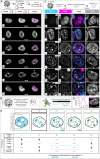
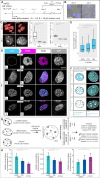
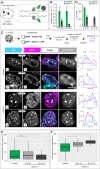
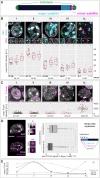


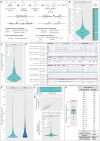

Similar articles
-
Genome-wide Control of Heterochromatin Replication by the Telomere Capping Protein TRF2.Mol Cell. 2018 May 3;70(3):449-461.e5. doi: 10.1016/j.molcel.2018.03.036. Mol Cell. 2018. PMID: 29727617
-
Developmental Changes in Genome Replication Progression in Pluripotent versus Differentiated Human Cells.Genes (Basel). 2024 Feb 27;15(3):305. doi: 10.3390/genes15030305. Genes (Basel). 2024. PMID: 38540366 Free PMC article.
-
The scaffold protein Nde1 safeguards the brain genome during S phase of early neural progenitor differentiation.Elife. 2014 Sep 23;3:e03297. doi: 10.7554/eLife.03297. Elife. 2014. PMID: 25245017 Free PMC article.
-
Epigenomic replication: linking epigenetics to DNA replication.Bioessays. 2003 Jul;25(7):647-56. doi: 10.1002/bies.10305. Bioessays. 2003. PMID: 12815720 Review.
-
Global regulation of genome duplication in eukaryotes: an overview from the epifluorescence microscope.Chromosoma. 2008 Jun;117(3):243-60. doi: 10.1007/s00412-007-0145-1. Epub 2008 Jan 16. Chromosoma. 2008. PMID: 18197411 Review.
Cited by
-
Isoform-specific and ubiquitination dependent recruitment of Tet1 to replicating heterochromatin modulates methylcytosine oxidation.Nat Commun. 2022 Sep 2;13(1):5173. doi: 10.1038/s41467-022-32799-8. Nat Commun. 2022. PMID: 36056023 Free PMC article.
-
Replication Stress, Genomic Instability, and Replication Timing: A Complex Relationship.Int J Mol Sci. 2021 Apr 30;22(9):4764. doi: 10.3390/ijms22094764. Int J Mol Sci. 2021. PMID: 33946274 Free PMC article. Review.
-
Cytosine base modifications regulate DNA duplex stability and metabolism.Nucleic Acids Res. 2021 Dec 16;49(22):12870-12894. doi: 10.1093/nar/gkab509. Nucleic Acids Res. 2021. PMID: 34133727 Free PMC article.
-
H4S47 O-GlcNAcylation regulates the activation of mammalian replication origins.Nat Struct Mol Biol. 2023 Jun;30(6):800-811. doi: 10.1038/s41594-023-00998-6. Epub 2023 May 18. Nat Struct Mol Biol. 2023. PMID: 37202474
-
Mobile origin-licensing factors confer resistance to conflicts with RNA polymerase.Cell Rep. 2022 Mar 22;38(12):110531. doi: 10.1016/j.celrep.2022.110531. Cell Rep. 2022. PMID: 35320708 Free PMC article.
References
-
- Dimitrova D.S., Gilbert D.M.. The spatial position and replication timing of chromosomal domains are both established in early G1 phase. Mol. Cell. 1999; 4:983–993. - PubMed
-
- Hyrien O., Marheineke K., Goldar A.. Paradoxes of eukaryotic DNA replication: MCM proteins and the random completion problem. BioEssays. 2003; 25:116–125. - PubMed
-
- Fragkos M., Ganier O., Coulombe P., Mechali M.. DNA replication origin activation in space and time. Nat. Rev. Mol. Cell Biol. 2015; 16:360–374. - PubMed
Publication types
MeSH terms
Substances
LinkOut - more resources
Full Text Sources
Research Materials
Miscellaneous

